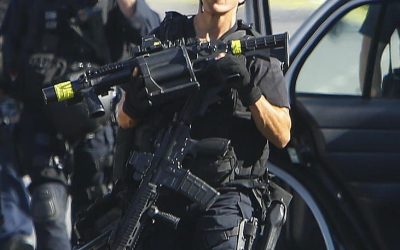Law enforcement professionals are the backbone of our society, tasked with maintaining order and ensuring the safety of citizens. The demands of the job require officers to be physically fit, agile, and resilient. To ensure that our law enforcement officers are up to the challenge, fitness testing has become an integral part of the hiring and ongoing training processes. In this blog post, we delve into the science behind law enforcement fitness testing, exploring the principles that guide these assessments and shedding light on the evolution of popular tests like the PARE (Physical Abilities Requirement Evaluation) and COPAT (Correctional Officers Physical Abilities Test) in Canada.

The Science Behind Fitness Assessments:
Law enforcement fitness testing is not a mere formality but a scientifically designed process aimed at evaluating an officer’s physical capabilities. The tests are carefully crafted to simulate real-life scenarios, ensuring that officers are prepared for the physical demands they may encounter in the field. The purpose of standardized law enforcement fitness tests was to define minimum Bona Fide Occupational Requirement (BFOR) medical and physical abilities standards for law enforcement employees and to identify the supportive BFOR physical fitness abilities required in the performance of the minimum BFOR physical abilities standard. The key scientific principles behind these assessments include:
- Specificity: Fitness tests are tailored to mimic tasks that law enforcement officers commonly face, such as chasing a suspect, climbing obstacles, or carrying equipment. This specificity ensures that the tests accurately reflect the physical demands of the job.
- Validity and Reliability: Fitness tests must be valid, meaning they measure what they intend to measure, and reliable, providing consistent results over time. Rigorous scientific validation ensures that the tests effectively assess an officer’s fitness and can be trusted as a reliable measure of their capabilities.
- Biomechanics: Understanding the biomechanics of human movement is crucial in designing effective fitness tests. This involves analyzing the mechanics of different physical activities to create assessments that optimize performance and minimize the risk of injury.
- Physiology: Fitness tests take into account physiological factors such as cardiovascular endurance, muscular strength, and flexibility. These tests are designed to gauge an officer’s overall physical health and ability to perform under stress.
Evolution of Fitness Tests in Canada:
In Canada, two widely recognized fitness tests for law enforcement officers are the PARE and COPAT. The recommended physical activities reflect the activities included in the COPAT, SOPAT and POPAT tests developed by D W Farenholtz and E C Rhodes through the Justice Institute of British Columbia in 1985. The RCMP also adopted a similar test to POPAT (the minimum BFOR physical abilities test recommended by the Canadian Association of Chiefs of Police, 1987) with minor modifications, reflected within the design of this recommended COPAT, and uses the acronym PARE (Physical Ability Requirement Evaluation).
- PARE (Physical Abilities Requirement Evaluation): Developed by the Royal Canadian Mounted Police (RCMP), the PARE is a standardized test that assesses an officer’s ability to perform essential job tasks. It includes tasks like climbing stairs, jumping, pushing, pulling, and running. The PARE has become a benchmark for physical fitness assessment in various Canadian law enforcement agencies. In 1991 the RCMP started using the PARE for applicants as part of their recruiting process (requiring PARE in 4:45 min. or less) as well as an exit criteria for recruits at the Training Academy (requiring PARE in 4:00 or less). In 1995 following a complaint from an applicant heard by a Canadian Human Rights Tribunal in regard to the 1.8 m (6 foot) mat, the mat distance was changed to 1.5 m (5 foot), and a 5 second penalty was added when one failed to fully clear the mat. At this time a two second penalty was also added when knocking down a hurdle. The original protocol was asking participant to redo the jump over the mat or to go back and replace the stick and redo the jump over it when failing these items. These changes were better aligned with what would be expected in the field. In 1996 the RCMP required PARE participation from their incumbent officers as part of their Periodical Health Assessment (every two years). While the participation was mandatory, the police officers did not have to meet a specific standard, with the exception of certain specialized units requiring a PARE of 4:00 minutes or less. Learn more about the PARE: PARE Overview

- COPAT (Correctional Officers Physical Abilities Test): The COPAT is another popular fitness test used by law enforcement agencies in Canada. Developed by D W Farenholtz and E C Rhodes through the Justice Institute of British Columbia in 1985, the COPAT evaluates an officer’s agility, strength, and endurance through a series of obstacle course activities. The initial phase of physical work is performed during the Correctional Officers response to an urgent situation which is most often precipitated by an Officer’s observance of a problem (between inmates or a personal confrontation with an inmate). This includes tasks such as having to run a distance of about 160 meters which included the motor skill abilities of climbing stairs (up and down), turning corners and changing directions, avoiding obstacles (adjusting stride length and positioning of feet) and climbing over obstacles (about 1 meter in height). Explore the COPAT: COPAT Details

Law enforcement fitness testing is not only a regulatory requirement but a crucial element in ensuring the safety and effectiveness of our officers. The scientific principles that underpin these assessments help create comprehensive and reliable tests that accurately reflect an officer’s capabilities. At Blue Line Fitness Testing, we are committed to upholding the highest standards in law enforcement fitness testing, contributing to the overall well-being and success of our dedicated law enforcement professionals.
Contact Blue Line Fitness Testing for more information on our services and commitment to excellence in law enforcement fitness testing: Contact Us
For more information on PARE prep and testing or any of the other law enforcement testing Blue Line offers, check out these pages and posts:
Becoming a Fish & Wildlife Officer in Alberta
Everything you Need to know about being a Sheriff in Alberta
Sirens, Slammers and Service – A podcast for first responders






